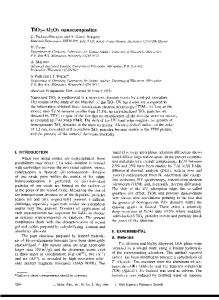Oxidative Desulfurization of DBT with H 2 O 2 over 3DOM H 3 PW 12 O 40 /Al 2 O 3 Catalyst
- PDF / 781,265 Bytes
- 6 Pages / 595.276 x 841.89 pts (A4) Page_size
- 12 Downloads / 333 Views
671
https: //doi. org/10.1007/s11595-020-2305-6
Oxidative Desulfurization of DBT with H2O2 over 3DOM H3PW12O40/Al2O3 Catalyst LI Ang1, LEI Jiaheng1*, DU Yue2*, GUO Zhenran1, DU Xiaodi1
(1. School of Chemistry, Chemical Engineering and Life Sciences, Wuhan University of Technology, Wuhan 430070, China; 2. School of Materials Science and Engineering, Wuhan University of Technology, Wuhan 430070, China)
Abstract: A series of heteropoly acid (HPA) based Al2O3 catalysts with three-dimensional ordered (3DOM) structure were synthesized by colloidal crystal template method. Interconnected macropores (250 nm) could be clearly observed by scanning electron microscope (SEM) and transmission electron microscope (TEM). Mesopores could be detected by N2 adsorption-desorption isotherms which further confirmed the 3DOM structural characteristics of catalyst. Moreover, Keggin-type HPW was highly dispersed in the Al2O3 framework, which suggested by powder X-ray diffraction (XRD) and Fourier transform infrared spectra (FT-IR) results. The oxidation desulfurization (ODS) performance of 3DOM H3PW12O40/Al2O3 of refractory sulphur compounds was evaluated in the presence of hydrogen peroxide. It oxidized 98.5% of dibenzothiophene (DBT) into corresponding sulfone within 3 h, which exhibited superior ODS performance than corresponding mesoporous and microporous H3PW12O40/Al2O3 catalyst. The enhancement of ODS efficiency is related to the improvement of mass transfer of DBT in the pore channel resulting from the interconnected 3DOM structure. Furthermore, the as-prepared catalyst still demonstrates outstanding cycle performance after 6 runs, which could be easily recovered from the model fuel. Key words: 3DOM structure; oxidative desulfurization; H3PW12O40/Al2O3 catalyst
1 Introduction Recent years, the increasingly stringent fuel quality standards have motivated an increase research of efficient fuel desulfurization technology to get rid of aromatic sulfur [1,2]. Conventionally, hydrodesulfurization (HDS) could remove aliphatic and acyclic sulphur compounds in fuel oil effectively. However, it was limited in the removal of aromatic sulfur, such as benzothiophene (BT), dibenzothiophene (DBT) and 4,6-Dimethyldi-benzothiophene (4,6-DMDBT)[3]. Oxidative desulfurization (ODS) was considered to be one of the most promising alternative desulfurization technologies to remove DBT and its derivatives, due to mild reaction conditions and high efficiency[4]. Moreover, various catalysts including heteropoly acid, acetic © Wuhan University of Technology and Springer-Verlag GmbH Germany, Part of Springer Nature 2020 (Received: July 29, 2019; Accepted: Oct. 18, 2019) LI Ang(李昂): E-mail: [email protected] *Corresponding authors: LEI Jiaheng(雷家珩): Prof.; E-mail: [email protected]; DU Yue(杜岳): Ph D Candidate; E-mail: duyue@ whut.edu.cn Funded by the National Natural Science Foundation of China (No.21476177)
acid[5], formic acid[6], and heteropoly acids[7] have been investigated in ODS system. Among these, Keggin type HPAs, owing to its pseudo-liquid phase ca
Data Loading...











